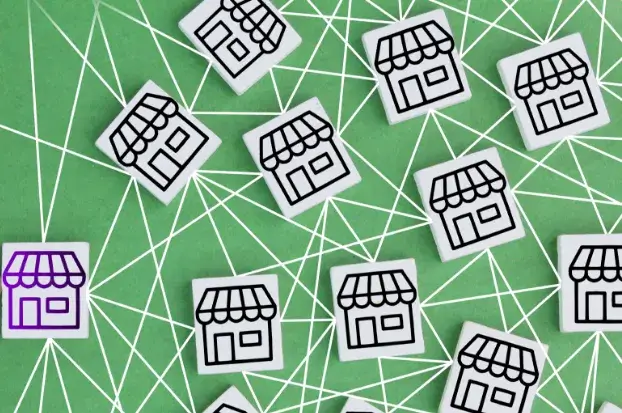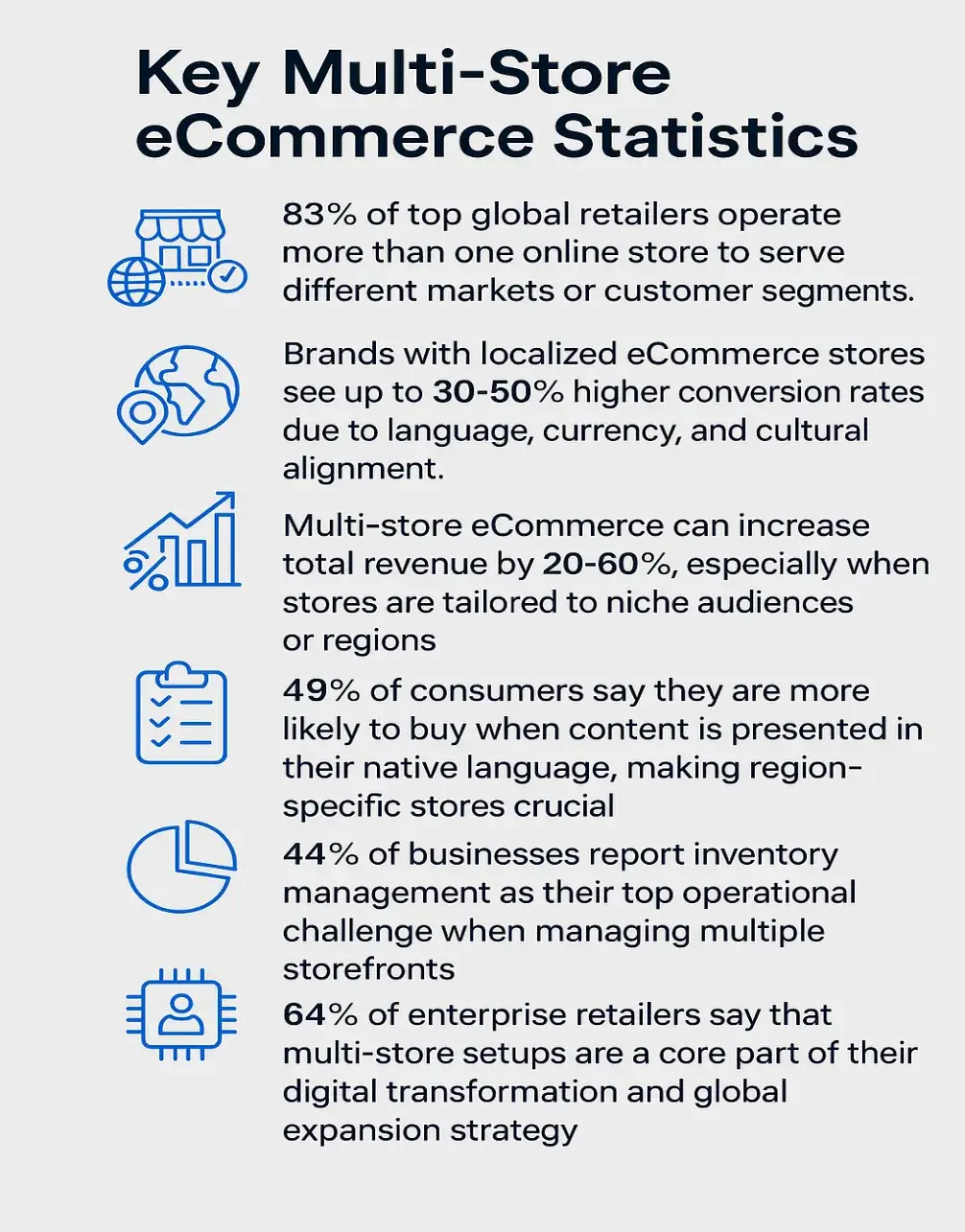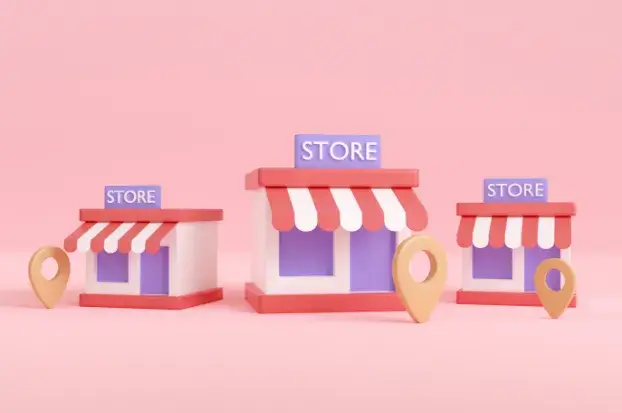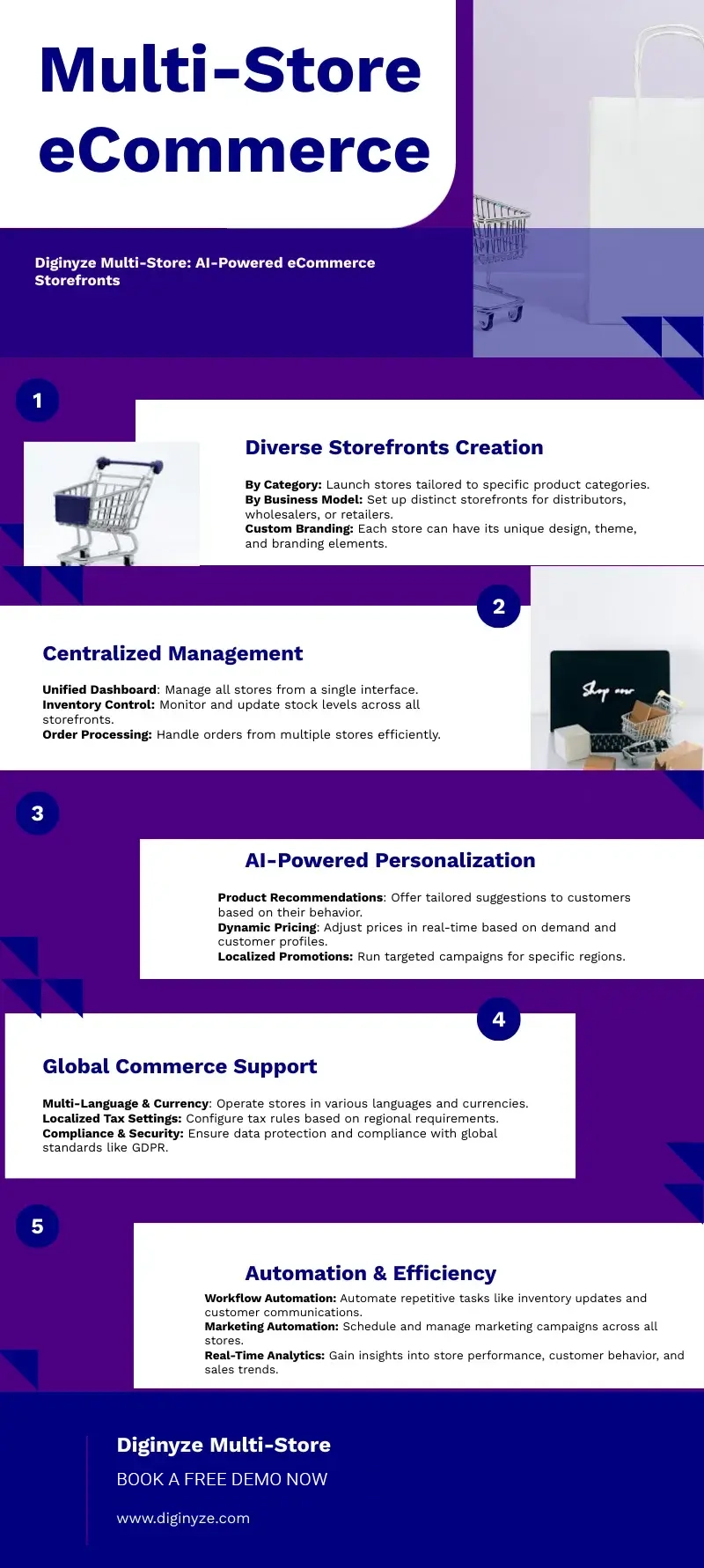Table Of Content
Introduction Understanding the Power of Multi-Store eCommerce The Evolution of Multi-Channel Retail Essential Components of a Successful Multi-Store eCommerce Solution Preparing Your Business for Multi-Store Expansion Step-by-Step Implementation for Your First Additional Store Marketing Strategies for Multi-Store Success Common Challenges in Multi-Store Operations and How to Overcome Them Conclusion FAQs
Introduction
Did you know 83% of top retailers have multiple online stores? This is because multi-store ecommerce is key to success today. It lets businesses reach different customers by setting up stores for different areas, languages, or products. This way, they grow without getting overwhelmed.
- Multi-store ecommerce allows brands to serve niche markets with specialized branding and pricing.
- Centralized management tools reduce redundancy in inventory and customer data handling.
- Businesses can boost revenue by 30-50% through localized marketing campaigns per store.
- Scalability and customer segmentation are core advantages of multi-store setups.
- Risk is minimized by isolating issues to individual stores, not the whole brand.

Understanding the Power of Multi-Store eCommerce
Multi-store ecommerce lets businesses reach more customers through different stores. It helps companies serve various markets or niches with their own brands and products. Here’s how it works:
What Defines a Multi-Store Ecommerce Business?
A multi-store setup means managing two or more online stores together. These can be different brands, regional sites, or shops for specific products. For example, a fitness brand might have one store for yoga gear and another for cycling.
Each store has its own products and prices. However, inventory and customer information are overseen by a unified system. This keeps things efficient.

Key Differences Between Single and Multi-Store Operations
- Inventory : Single stores track stock in one place. Multi-store systems need updates across all sites to avoid overselling.
- Marketing : Multi-store strategies need custom campaigns for each store. Single-store sites use a single approach.
- Technology : Multi-store platforms need to grow with multiple domains and payment gateways.
The Evolution of Multi-Channel Retail
Retail started with physical stores, then moved to single online shops. Now, multistore ecommerce combines websites, marketplaces, and apps. This change meets consumer needs for unique shopping experiences.
By using these systems, companies can grow without losing control. The right tools make it easy to scale, turning complexity into a strength.
The Business Case for Expanding to Multiple Stores
Expanding to multiple stores is more than a choice it's a smart move for growth. A multi-store ecommerce solution opens doors to new markets. It also helps reduce dependence on one platform and keeps up with changing customer habits.
- Boost Revenue Streams : CReach different customers with stores focused on specific interests or areas.
- Reduce Risk : Spread sales across platforms like Amazon and Walmart to avoid relying on one place.
- Scale with Flexibility:Test products in local markets before a big launch and adjust to local tastes.
Think of a cosmetics brand launching a luxury line on its own site and budget-friendly items on Walmart. This way, it reaches different customers without mixing up its main brand. Also, expanding to Europe or Asia lets businesses adjust prices, languages, and payment methods for each area without changing their main setup.
Studies show brands with multiple stores keep up to 30% more customers by meeting different needs. While starting takes money, the benefits in reaching more customers and being more stable are worth it. A smart multi-store plan is not just about growing it's about building a business that can last.

Essential Components of a Successful Multi-Store eCommerce Solution
A multi-store ecommerce solution's success depends on four key areas. These components help maintain seamless functionality across every channel. They work together to create a system that grows well and gives customers a consistent experience.
1. Centralized Inventory Management Systems
Centralized systems track stock levels in real time. This prevents overselling and waste. Platforms like Diginyze an AI powered eCommerce solution for enterprises help adjust inventory automatically. This avoids stockouts and ensures orders are filled correctly across all stores.
Also Read : From Chaos to Control: How AI is Transforming eCommerce Inventory
2. Integrated Customer Data Platforms
Unified customer profiles get rid of data silos. eCom platform like Diginyze combine purchase history, preferences, and interactions into one record. This leads to personalized recommendations and loyalty programs for each shopper.
3. Unified Analytics and Reporting
Aggregated data from all channels gives a full picture of performance. Reports show top-selling products, regional trends, and conversion rates. Solutions like Diginyze AI driven Analytics make data useful for making strategy changes.
4. Cross-Channel Marketing Capabilities
Unified marketing tools let brands run campaigns that fit brand standards but also adapt to different audiences. eCommerce platform like Diginyze campaign orchestration allow for testing ads across stores. This boosts ROI without losing the brand's voice.
These components are the foundation of a scalable multi-store ecommerce setup. Without them, businesses face disjointed operations and miss chances to connect with customers.

Preparing Your Business for Multi-Store Expansion
Expanding into multi-store ecommerce needs careful planning. Before opening new stores, you must prepare well. This part will guide you on how to get ready for growth.
Assess Your Current Infrastructure
First, check your current systems. Ask if your inventory can handle many stores. Does your team know how to work across different channels? You'll need tools like ERP software and CRM systems that grow with you.
Make sure your tech can manage everything from one place. This avoids the need for manual fixes.
Define Your Multi-Channel Strategy
- Find out where you want to sell geographic areas or specific groups.
- Make sure your branding and messages are the same everywhere.
- Prioritize the channels where your audience spends the most time, such as apps or social platforms.
Set Realistic Timelines and Budgets
Plan your expansion in steps. Begin by upgrading your technology and equipping your team with the necessary training. Then, do soft launches to get feedback. Remember to budget for unexpected costs like legal fees in new places or support for different languages.
Keep track of your progress every week. This helps you stay on track.
Pro tip: Use eCom platforms that have built-in features for multiple stores like Diginyze. Focus on one step at a time to maintain quality and clarity. Concentrate on launching one store at a time to maintain high standards.

Selecting the Right Multistore eCommerce Platform
Choosing the right multi-store ecommerce solution is key to growing your business. Your platform must grow with you and work well with what you already have. Start by thinking about what you need, like how it scales, supports different languages and currencies, and manages inventory.
- Scalability : Is the platform capable of supporting fast expansion without sacrificing performance?
- Customization : Does it allow unique branding per storefront?
- Integration : Does it connect with payment gateways, CRM tools, and logistics partners?
Think about all costs, not just the initial ones. Development, training, and ongoing support can add up. Look at how other businesses in your field have expanded. Make sure the platform is secure for international sales.
Make a list to compare platforms based on what's important to you. Choose one that fits your future plans, your team's skills, and your timeline. The right choice now will help you run smoothly for years.
Step-by-Step Implementation for Your First Additional Store
Opening a new online store calls for thoughtful strategy and detailed preparation. Let’s walk through the steps to launch a new store seamlessly. First, figure out what your brand needs and how it fits with your ecommerce goals.
Planning Your Store Structure and Design
Start by planning your store structure to fit your business. Choose what to keep the same, like logos, and what to change for different places or people. Try out designs without coding using drag-and-drop tools.
Setting Up Product Catalogs Across Stores
- Create shared product databases but let each store have its own prices and descriptions.
- Use category filters to organize products in a way that makes sense for each store’s customers.
- Make sure content is right for different languages or regions automatically.
Configuring Payment and Shipping Options
Choose payment gateways that work for each store’s location. Set up shipping rules based on local taxes and delivery partners. Test everything in a test environment to avoid problems.
Testing Before Launch
- 1. Check that inventory is synced across stores to avoid mistakes.
- 2. Make sure the checkout works well on phones and computers.
- 3. Test how the site handles a lot of visitors to make sure it stays fast.
Keep track of every test and fix problems before you go live. Regular checks after launch help keep everything running smoothly in your multi-store setup.
Also read - eCommerce Payment Trends You Can’t Ignore
Managing Inventory across Multiple Storefronts
Running a multi-store ecommerce business needs precise inventory control. A strong multi-store ecommerce solution tracks products across all channels. This prevents stock mismatches, keeping customer trust and operations running smoothly.
Real-Time Synchronization Techniques
Platforms like Diginyze use APIs for instant inventory sync. Key techniques include:
- API integrations : Connect warehouses and marketplaces for live updates
- Middleware solutions : Bridge legacy systems with cloud-based dashboards
- Automated alerts : Notify teams about stock changes via email or in-app notifications
Handling Store-Specific Products
Catalog segmentation keeps inventory organized. Implement:
- Control product visibility to ensure only relevant items appear on each store.
- SKU tagging for location-specific items
- Geolocation filters for regional product availability
Preventing Overselling and Stockouts
Effective multi-store ecommerce systems include:
- Buffer stock thresholds (e.g., 10% reserve for high-demand items)
- Automated reorder points triggered at 15% remaining stock
- Machine learning algorithms predicting demand fluctuations
Using these strategies with a centralized dashboard gives full visibility. Retailers like Gymshark manage 12+ international stores without stock issues. Synchronization and segmentation turn inventory management into a competitive edge.
Marketing Strategies for Multi-Store Success
Marketing in multi-store ecommerce needs a two-part plan. It must align brand messages across all platforms and tailor strategies for each one's strengths. Good campaigns find a balance between being consistent and flexible. This way, they can connect with different customer groups. Here are some steps to boost your multistore ecommerce success.
- Cross-Promote Strategically: Show off special deals in each store to get more people to visit. For example, a fashion brand might offer seasonal sales in its main store. It could also have a pop-up virtual store for limited-edition items.
- Leverage Unified Branding: Keep logos and tone the same across all platforms. But, change visuals to fit each audience. A beauty brand might use bright pictures on Instagram. It could focus more on product details on its main website.
- Optimize for Local Markets: Use ads and landing pages that target specific areas. Tools like Google Ads help avoid duplication. This way, you can meet local tastes without extra work.
SEO is key. Use keywords that fit each store's focus. For instance, a wellness site might use "organic skincare" while a premium site uses "luxury skincare". Social media should match each store's theme, with unique handles for each brand. Email marketing can send special offers based on what customers have bought before, linking to the right store.
Use data to guide your spending. Look at click-through rates and conversion paths to see where to put more money. Big brands like Sephora and Nike do this to focus on stores that get more attention. Regularly test different messages to keep up with what customers like.
By matching strategy with multi-store ecommerce flexibility, businesses can turn complexity into a strength. Each store can build deeper connections with customers, helping the whole business grow.

Common Challenges in Multi-Store Operations and How to Overcome Them
Starting online multiple stores opens up new chances but also faces challenges. This part shows how to tackle these problems with the right tools. A strong multi-store ecommerce solution helps keep things consistent, manage data, and offer support.
Maintaining Brand Consistency
Keep your brand's voice the same everywhere. Use platforms like Diginyze handle logos, colors, and messages from one place. Consistent reviews help maintain visual and tonal consistency across all platforms.
Managing Multiple Customer Bases
Each customer group needs its own experience. Use CRM tools to sort out your audience. Dynamic content makes offers personal, and analytics help improve without losing your brand.
Technical Integration Issues
Systems that don't talk to each other slow things down. Pick a multi-store ecommerce solution with APIs for inventory, payments, and CRM. Real-time updates cut down on stock mistakes and make orders more accurate.
Scaling Customer Support
Adding more support staff can be tough. Set up a single ticket system like AI chatbots for common questions. Train your team on policies for all stores to keep service high.
Conclusion:
Multi-store eCommerce isn’t just about having more shops it’s a smarter way to scale, adapt, and win in a competitive market. With the right eCommerce platform, you can manage multiple storefronts from one hub, tailor experiences to local markets, and stay agile in the face of change.
That’s where Diginyze makes a difference. As an AI-powered eCommerce solution, Diginyze brings smart automation, real-time insights, and centralized control to your multi-store strategy. Whether you’re launching your first store or your fifty store, Diginyze helps you grow faster with less complexity and more confidence.

FAQs
What is multi-store eCommerce?
Multi-store eCommerce means running many online stores under one business. It helps brands reach different customers, enter new markets, and sell more through various channels. This includes marketplaces and their own websites.
What are the benefits of a multi-store eCommerce solution?
A multi-store eCommerce solution offers many benefits. It increases market reach and diversifies income. It also helps target customers better and stay resilient against problems. This way, businesses can meet different customer needs while using a single system.
How does a multi-store operate differently than a single-store?
A multi-store has different strategies for managing inventory, marketing, and customer service. This complexity lets brands tailor their approach for each market or region. It's more challenging but allows for specific strategies for each area.
What key components are essential for a successful multi-store eCommerce platform?
Key components include systems for managing inventory and customer data together. They also need unified analytics, reporting, and marketing across channels. These elements ensure consistency and effective operations across stores.
How can businesses prepare for multi-store expansion?
Businesses should check their current setup, plan a multi-channel strategy, and set realistic goals and budgets. This preparation helps the transition go smoothly and aligns with business goals.
What factors should we consider when selecting a multistore eCommerce platform?
Important factors include scalability, integration, support for multiple currencies and languages, and customization. Choosing a platform that meets current and future needs is essential.
What steps are involved in implementing our first additional store?
Setting up a new store involves planning its structure and design, creating product catalogs, and setting up payment and shipping. Each step should be done carefully to avoid mistakes and ensure everything is ready to go.
How can we manage inventory effectively across multiple storefronts?
Effective inventory management uses real-time updates, strategic product management, and prevents overselling. Technology and streamlined processes help keep inventory accurate across all stores.
What marketing strategies are effective for multi-store operations?
Effective strategies include coordinated marketing across channels, using each platform's strengths, and cross-promotion. Tailored SEO for each store is also key. It's important to balance brand consistency with channel optimization to engage customers well.
What common challenges do businesses face in multi-store operations?
Challenges include keeping brand consistency, managing multiple customer bases, and technical integration issues. Scaling customer support is also a challenge. Using technology and proactive strategies can help overcome these and improve customer experiences.
Recent Blogs
Explore latest insights and trends in technology and eCommerce.
Case Studies
Your Digital Transformation Starts Here!
Join thousands of businesses transforming with Diginyze. Sign up today and start now!






















